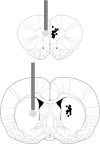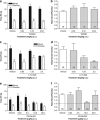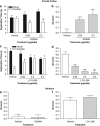Selective blockade of dopamine D3 receptors enhances while D2 receptor antagonism impairs social novelty discrimination and novel object recognition in rats: a key role for the prefrontal cortex
- PMID: 22030711
- PMCID: PMC3261029
- DOI: 10.1038/npp.2011.254
Selective blockade of dopamine D3 receptors enhances while D2 receptor antagonism impairs social novelty discrimination and novel object recognition in rats: a key role for the prefrontal cortex
Abstract
Dopamine D(3) receptor antagonists exert pro-cognitive effects in both rodents and primates. Accordingly, this study compared the roles of dopamine D(3) vs D(2) receptors in social novelty discrimination (SND), which relies on olfactory cues, and novel object recognition (NOR), a visual-recognition task. The dopamine D(3) receptor antagonist, S33084 (0.04-0.63 mg/kg), caused a dose-related reversal of delay-dependent impairment in both SND and NOR procedures in adult rats. Furthermore, mice genetically deficient in dopamine D(3) receptors displayed enhanced discrimination in the SND task compared with wild-type controls. In contrast, acute treatment with the preferential dopamine D(2) receptor antagonist, L741,626 (0.16-5.0 mg/kg), or with the dopamine D(3) agonist, PD128,907 (0.63-40 μg/kg), caused a dose-related impairment in performance in rats in both tasks after a short inter-trial delay. Bilateral microinjection of S33084 (2.5 μg/side) into the prefrontal cortex (PFC) of rats increased SND and caused a dose-related (0.63-2.5 μg/side) improvement in NOR, while intra-striatal injection (2.5 μg/side) had no effect on either. In contrast, bilateral microinjection of L741,626 into the PFC (but not striatum) caused a dose-related (0.63-2.5 μg/side) impairment of NOR. These observations suggest that blockade of dopamine D(3) receptors enhances both SND and NOR, whereas D(3) receptor activation or antagonism of dopamine D(2) receptor impairs cognition in these paradigms. Furthermore, these actions are mediated, at least partly, by the PFC. These data have important implications for exploitation of dopaminergic mechanisms in the treatment of schizophrenia and other CNS disorders, and support the potential therapeutic utility of dopamine D(3) receptor antagonism.
Figures








Similar articles
-
Blockade of dopamine D(3) receptors in frontal cortex, but not in sub-cortical structures, enhances social recognition in rats: similar actions of D(1) receptor agonists, but not of D(2) antagonists.Eur Neuropsychopharmacol. 2009 Jan;19(1):23-33. doi: 10.1016/j.euroneuro.2008.07.012. Epub 2008 Sep 14. Eur Neuropsychopharmacol. 2009. PMID: 18793829
-
S33084, a novel, potent, selective, and competitive antagonist at dopamine D(3)-receptors: I. Receptorial, electrophysiological and neurochemical profile compared with GR218,231 and L741,626.J Pharmacol Exp Ther. 2000 Jun;293(3):1048-62. J Pharmacol Exp Ther. 2000. PMID: 10869410
-
S33084, a novel, potent, selective, and competitive antagonist at dopamine D(3)-receptors: II. Functional and behavioral profile compared with GR218,231 and L741,626.J Pharmacol Exp Ther. 2000 Jun;293(3):1063-73. J Pharmacol Exp Ther. 2000. PMID: 10869411
-
The potential role of dopamine D₃ receptor neurotransmission in cognition.Eur Neuropsychopharmacol. 2013 Aug;23(8):799-813. doi: 10.1016/j.euroneuro.2013.05.006. Epub 2013 Jun 20. Eur Neuropsychopharmacol. 2013. PMID: 23791072 Free PMC article. Review.
-
Dopamine D₃ receptor antagonism--still a therapeutic option for the treatment of schizophrenia.Naunyn Schmiedebergs Arch Pharmacol. 2013 Feb;386(2):155-66. doi: 10.1007/s00210-012-0806-3. Epub 2012 Nov 6. Naunyn Schmiedebergs Arch Pharmacol. 2013. PMID: 23128852 Review.
Cited by
-
Oxytocin improves behavioral and electrophysiological deficits in a novel Shank3-deficient rat.Elife. 2017 Jan 31;6:e18904. doi: 10.7554/eLife.18904. Elife. 2017. PMID: 28139198 Free PMC article.
-
Efficacy of a glycine transporter 1 inhibitor TASP0315003 in animal models of cognitive dysfunction and negative symptoms of schizophrenia.Psychopharmacology (Berl). 2015 Aug;232(15):2849-61. doi: 10.1007/s00213-015-3920-3. Epub 2015 Apr 15. Psychopharmacology (Berl). 2015. PMID: 25869273
-
Reduction in the activity of VTA/SNc dopaminergic neurons underlies aging-related decline in novelty seeking.Commun Biol. 2023 Dec 2;6(1):1224. doi: 10.1038/s42003-023-05571-x. Commun Biol. 2023. PMID: 38042964 Free PMC article.
-
The polymorphisms of candidate pharmacokinetic and pharmacodynamic genes and their pharmacogenetic impacts on the effectiveness of risperidone maintenance therapy among Saudi children with autism.Eur J Clin Pharmacol. 2024 Jun;80(6):869-890. doi: 10.1007/s00228-024-03658-w. Epub 2024 Feb 29. Eur J Clin Pharmacol. 2024. PMID: 38421437
-
Dopamine D3 Receptors Inhibit Hippocampal Gamma Oscillations by Disturbing CA3 Pyramidal Cell Firing Synchrony.Front Pharmacol. 2016 Jan 6;6:297. doi: 10.3389/fphar.2015.00297. eCollection 2015. Front Pharmacol. 2016. PMID: 26779018 Free PMC article.
References
-
- Abe H, Ishida Y, Iwasaki T. Perirhinal N-methyl-D-aspartate and muscarinic systems participate in object recognition in rats. Neurosci Lett. 2004;356:191–194. - PubMed
-
- Aggleton JP, Keen S, Warburton EC, Bussey TJ. Extensive cytotoxic lesions involving both the rhinal cortices and area TE impair recognition but spare spatial alternation in the rat. Brain Res Bull. 1997;43:279–287. - PubMed
-
- Ainge JA, Heron-Maxwell C, Theofilas P, Wright P, de Hoz L, Wood ER. The role of the hippocampus in object recognition in rats: examination of the influence of task parameters and lesion size. Behav Brain Res. 2006;167:183–195. - PubMed
-
- Baluch F, Itti L. Mechanisms of top-down attention. Trends Neurosci. 2011;34:210–224. - PubMed
Publication types
MeSH terms
Substances
LinkOut - more resources
Full Text Sources
Other Literature Sources
Miscellaneous

